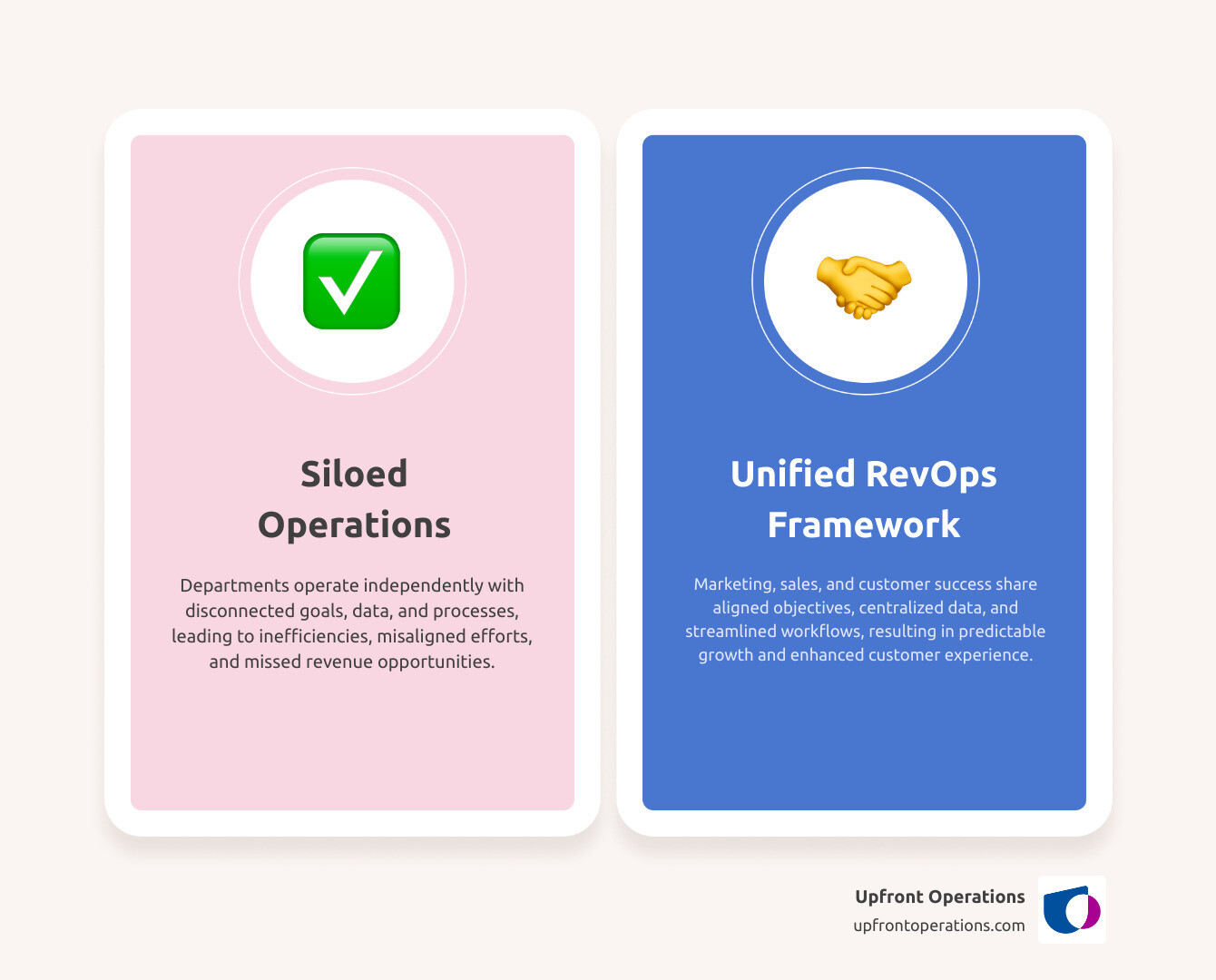RevOps Strategies Unleashed: Aligning for Growth
Discover how RevOps strategies unify teams, data, and tech for predictable revenue growth and a seamless customer experience.
Discover how RevOps strategies unify teams, data, and tech for predictable revenue growth and a seamless customer experience.

RevOps strategies are the key to breaking down departmental silos and creating a unified approach to revenue generation. Here are the core strategies every business needs:
Growing a business is tough, especially when teams operate in silos. Marketing generates off-target leads, sales gets swamped with the wrong prospects, and customer success is left in the dark about new customers.
This chaos is expensive. 65% of marketing and sales professionals struggle with leadership misalignment, and companies with mature RevOps are twice as likely to exceed revenue goals than their siloed counterparts.
Revenue Operations (RevOps) changes everything by connecting the teams responsible for driving revenue—marketing, sales, customer success, and finance—into a seamless, unified system. It's about breaking down the walls between departments and ensuring everyone works toward common objectives with shared data and processes.
The results speak for themselves:
But implementing effective RevOps strategies isn't just about reorganizing teams. It requires the right mix of people alignment, process optimization, and technology integration to create predictable, sustainable growth.
I'm Ryan T. Murphy, founder of UpfrontOps. Over 12 years, I've helped 32 companies implement RevOps strategies that cut waste and open up millions in revenue. By using smart automation, clean data, and better systems, I've seen sales cycles shorten by 28% and customer journeys become seamless.

Quick look at revops strategies:
Imagine marketing celebrating 500 new leads while sales struggles because only 10 are qualified. Meanwhile, customer success is clueless about promises made during the sale.
This is a common problem. 68% of companies report negative impacts from a lack of visibility into cross-functional projects. Silos hurt your teams, customers, and bottom line.

Effective RevOps strategies begin with aligning everyone toward the same goals. This involves creating shared KPIs for the entire revenue team and fostering cross-functional collaboration so marketing, sales, and customer success work together seamlessly.
One area that often gets overlooked is the relationship between sales and finance. While collaboration between sales and marketing works for 3 out of 4 companies, only 12% report solid collaboration between sales and finance. This disconnect can create major headaches when it comes to forecasting, pricing, and resource allocation.
Implementing RevOps strategies isn't just about reorganizing your org chart. It requires thoughtful change management, clear communication, and the right processes to support your newly aligned teams.
Aligning teams requires concrete strategies for accountability and shared ownership.
Shared revenue goals form the cornerstone of alignment. When marketing's success is measured by revenue generated, not just lead volume, quality suddenly matters more than quantity. Sales provides feedback on lead quality, and customer success becomes invested in the entire customer journey.
Unified metrics eliminate the finger-pointing that happens when departments track different numbers. Instead of celebrating separate conversion rates, everyone focuses on the metrics that actually drive revenue growth.
Regular cross-departmental meetings are collaborative sessions where teams share insights, solve problems, and coordinate efforts.
Creating a RevOps playbook gives everyone a roadmap to follow. This living document outlines how leads move through your system, who's responsible for what, and how teams should work together, ensuring consistency as you scale.
The RACI framework (Responsible, Accountable, Consulted, Informed) brings clarity to chaos. When everyone knows exactly who does what, you eliminate confusion. This is particularly important since less than 36% of companies report sufficient leadership involvement across all functions beyond sales and marketing.
Here's where RevOps strategies really shine: creating an amazing customer experience. When your teams are aligned, customers notice the difference.
71% of consumers expect personalized interactions, and 76% get frustrated when it doesn't happen. With aligned teams and shared data, you can deliver the personalized experience customers crave. Marketing nurtures prospects with relevant content, sales has the context for meaningful conversations, and customer success knows how to help each customer succeed.
This customer-focused approach pays off. A 5% boost in customer retention can increase profits by 25% to 95%. When you reduce churn and identify opportunities for upselling, you transform one-time buyers into long-term revenue streams.
The key is shifting from a "close and move on" mentality to a "win, retain, and grow" philosophy. This requires coordination across all revenue teams and can be accelerated with on-demand support for critical processes like lead nurturing and pipeline optimization.
For businesses looking to implement these strategies without hiring full-time specialists, on-demand RevOps support can provide the expertise you need when you need it. More info about our approach to delivering flexible RevOps solutions that grow with your business.
Data is often scattered across departments—marketing analytics, sales spreadsheets, and customer success systems. This is common, as only 30% of companies have a unified data strategy, leading to major decisions being made with incomplete information.

Think of centralized data as the engine that powers your RevOps strategies. The goal is to create a Single Source of Truth (SSOT) where all your customer and revenue data lives together. No more hunting through five different systems to understand why a deal fell through.
When your data is centralized, real-time analytics become possible, data-driven decisions replace gut feelings, and your teams start speaking the same language. Companies with real-time analytics outperform their peers by 80%.
Proper RevOps strategies eliminate the "too many tools" problem, where your team juggles platforms that don't talk to each other. Tech stack consolidation isn't about having fewer tools; it's about having the right tools that work together seamlessly.
Building a centralized data system starts with data integration. Your first priority is to bring scattered information from marketing, sales, support, and finance into one cohesive view.
Your CRM is the heart of this operation, but it's often neglected, leading to messy data. This is where on-demand CRM management becomes a game-changer, providing expert support to keep your system clean and effective when you need it.
Choosing scalable technology is crucial. Pick tools that can grow with your business and integrate well with others. You don't want to outgrow your systems in six months and start over.
Data governance is essential. Think of it as the rules of the road for your data—how it's collected, stored, accessed, and kept accurate. Without these guardrails, even the best technology becomes useless.
Essential technology categories for effective RevOps strategies include CRM platforms, marketing automation tools, sales engagement systems, business intelligence dashboards, customer success platforms, ERP systems, team communication tools, and data integration platforms.
With centralized data and integrated systems, you can open up the power of automation and AI. PwC found that 40% of work time can be reduced through automation and behavior change, freeing your sales team from manual data entry.
Start with workflow automation for simple, repetitive tasks like automatic lead scoring, behavior-based email sequences, or alerts for high-value prospect actions. These small automations add up to massive time savings.
Predictive analytics and AI take things further, helping you predict what will happen next. Which leads are most likely to convert? Which customers might churn? AI helps answer these questions with data instead of guesswork.
The personalization possibilities are endless. 71% of consumers expect personalized interactions, and AI makes this possible at scale, making your marketing and sales efforts more relevant.
Interestingly, 63% of software executives believe generative AI will be crucial to their RevOps framework, but only 25% have actually incorporated it into most functions. This gap represents a huge opportunity for businesses willing to accept these advanced RevOps strategies.
The companies that combine clean, centralized data with smart automation are the ones that will dominate their markets. For more insights on how technology is reshaping revenue operations, check out this Research from Gartner on high-growth companies adopting RevOps.
Effective RevOps strategies aren't a one-time fix. It's a continuous process of tuning each component of your revenue engine until it runs smoothly.
The magic happens when you focus on process optimization, streamline your pipeline management, and create seamless lead nurturing workflows. Your sales enablement gets stronger, your Go-to-Market (GTM) strategy becomes crystal clear, and you build a system for continuous improvement.
Think of it as creating a revenue engine that gets better every month. That's where our on-demand pipeline optimization services shine—we help keep your revenue machine running at peak performance, exactly when you need it.
Before fixing anything, you need to audit your current state. This diagnostic of your revenue operations is uncomfortable but necessary.
Start by mapping out your current processes from lead to loyal customer. This reveals hidden bottlenecks that cost you deals and frustrate your teams.
Identifying these friction points is where the real detective work begins. Maybe leads get stuck between marketing and sales handoffs, or your sales team spends hours on manual data entry. Perhaps your customer success team lacks visibility into promises made during the sale.
Dig deep into your current metrics—lead-to-customer conversion rates, Customer Acquisition Cost (CAC), and deal velocity. But numbers only tell part of the story. Gather stakeholder feedback directly from your teams; they know exactly where things get messy.
This step uncovers inefficiencies that drain resources. Facing this reality is the only way to build something better.
Once you know where you are, get clear on where you're going. This means setting shared revenue goals that everyone cares about, not just departmental targets that create internal competition.
Instead of marketing chasing lead volume while sales complains about quality, RevOps strategies align everyone around unified objectives. Marketing focuses on generating leads sales can convert. Sales focuses on closing deals that become profitable relationships. Customer success focuses on retention and expansion.
The key metrics shift dramatically with this approach:
| Traditional Siloed Metrics | Shared RevOps KPIs |
|---|---|
| Marketing: Website traffic, MQLs | Net ARR, Customer Lifetime Value (CLTV) |
| Sales: Individual quotas, deal count | Win rates, sales cycle length, pipeline health |
| Customer Success: CSAT scores, ticket volume | Customer retention, upsell revenue, Net Promoter Score |
| Finance: Monthly revenue, expenses | Profitability by segment, CAC payback period, LTV:CAC ratio |
When everyone's working toward Net ARR growth and improving Customer Lifetime Value, departmental silos start dissolving. Everyone wins when the customer succeeds.
Now, you build and refine your revenue engine. Standardize workflows, automate manual tasks, and create feedback loops for continuous improvement.
For example, if your lead handoff process is a disaster, define what makes a qualified lead, automate notifications, and ensure reps have full context on each prospect. No more "warm" leads that are actually ice cold.
Building these feedback loops is crucial because your market keeps changing. Implement systems where teams can easily report what's working and what isn't, then act on that feedback quickly.
We're big believers in A/B testing everything from sales messaging to email sequences. Why guess what works when you can know for sure? This continuous optimization approach keeps your RevOps strategies sharp.
You don't need to overhaul everything at once. Start with your biggest pain point. If it's lead nurturing, our on-demand lead nurturing services can provide immediate support while you build your broader strategy.
For more details about how our flexible approach can support your implementation, check out our pricing options. We believe in giving you exactly the support you need, when you need it, without the overhead of traditional consulting.
Implementing RevOps strategies is an investment that demands clear returns. Success isn't just about revenue growth; it's about understanding the efficiency of your entire revenue journey.

The numbers speak for themselves: companies with advanced-maturity RevOps functions are twice as likely to exceed revenue goals and 2.3 times as likely to exceed profit goals. But getting there isn't always smooth sailing.
Common challenges include stubborn data silos, stakeholders who aren't sold on the vision, and technology that works against you. The good news? These roadblocks are manageable when you know what to expect.
Calculating the ROI of your RevOps strategies requires digging into the details to understand what's working.
Tracking revenue growth is the starting point, but smart businesses look deeper, analyzing growth across different segments, products, and channels to see where growth is coming from.
Sales productivity increases are where things get exciting. Companies with RevOps see impressive 10-20% increases in sales productivity as reps close deals faster or spend less time on administrative tasks.
Deal velocity tells you how quickly opportunities move through your pipeline. Faster deals mean faster revenue generation. We also focus on cost savings analysis, as RevOps strategies streamline processes and reduce manual work. Automation can cut up to 40% of time spent on manual tasks.
Without RevOps, companies miss out on 19% higher revenue growth and 10% improved deal acceptance. That's real money left on the table.
The path to RevOps maturity has bumps. While 80% of organizations are on this journey, only 6% of tech businesses have reached a scaling or systemized level. If you're struggling, you're not alone.
Securing leadership buy-in is often the first hurdle. Build a compelling business case showing clear ROI and strategic necessity. Leadership involvement in sales and marketing is moderate (62%) but drops significantly in other functions (less than 36%), creating resistance.
Managing change across teams requires patience and strategy. Overcome natural resistance with clear communication, early stakeholder involvement, and solid training. Start small with high-impact projects to demonstrate value and build momentum.
Addressing skill gaps in data and AI is critical. While 80% of professionals believe data and AI skills are a priority, 88% feel they need more training. Bridging this gap through training or fractional expertise is essential for success.
The secret sauce? Start small with high-impact projects. Tackle one specific pain point first, like a messy lead handoff. Demonstrate success, build confidence, and then expand your RevOps strategies incrementally.
This is where our on-demand approach shines. Whether you need fractional RevOps expertise for strategy or specific support for pipeline optimization, flexible access to the right skills at the right time ensures implementation success.
RevOps strategies can feel overwhelming. Juggling teams, data, and systems leaves many leaders wondering where to begin. Here are the most common questions I hear.
The journey doesn't require a complete overhaul. The first step is an honest audit of your current processes to find inefficiencies, like lost leads or poor customer handoffs.
Next, align teams around shared revenue goals. This is often the hardest part but is critical for getting everyone rowing in the same direction.
The third foundational step is establishing a single source of truth for your data, typically within your CRM. This eliminates confusion during leadership meetings. We begin by pinpointing problems, aligning teams around measurable goals, and then centralizing data and integrating systems.
This foundational work sets the stage for everything that follows.
RevOps strategies transform the customer experience from fragmented to seamless. When teams share data and goals, customers no longer feel passed between disconnected departments.
RevOps creates consistency across every touchpoint. Marketing messages align with sales conversations. Sales teams have complete context on every prospect interaction. Customer success knows what was promised and can deliver from day one.
This alignment ensures smooth handoffs and proactive support, dramatically increasing satisfaction and retention. By breaking down silos, every step of the customer journey is optimized for a smoother, more personalized experience.
71% of consumers expect personalized interactions, and 76% are frustrated when they don't happen. RevOps makes personalization possible at scale by giving every team member the complete customer story.
This is a common question. Sales Ops focuses narrowly on optimizing the sales team's efficiency by streamlining processes, managing the tech stack, and analyzing sales-specific metrics.
RevOps takes a holistic approach, aligning the operations of all revenue-generating departments—sales, marketing, customer success, and even finance—to optimize the entire revenue process. While Sales Ops helps reps close deals, RevOps ensures those deals come from quality leads and become successful, long-term customers.
Think of it this way: Sales Ops optimizes one cylinder, while RevOps optimizes the entire engine. Sales Ops is vital but is just one component of the bigger RevOps picture.
RevOps encompasses the entire revenue journey, ensuring all activities are aligned toward a unified revenue goal. It's the difference between departmental optimization and organizational change.
In today's landscape, you need to scale efficiently. The RevOps strategies in this guide provide a roadmap to transform siloed operations into a revenue machine. Aligning teams, centralizing data, and optimizing processes creates a foundation for predictable revenue and unstoppable momentum.
You don't need a full-time team or expensive contracts to start. That's the beauty of on-demand RevOps services.
Whether you're a startup or an established company, fractional RevOps experts can provide strategic guidance without the full-time overhead. A fractional expert can dive in, assess your situation, and create a customized action plan.
If you're drowning in execution, on-demand microservices are game-changers. Need CRM cleanup, better lead nurturing, or faster sales cycles? Our on-demand lead nurturing and pipeline optimization services can fix friction points and get prospects moving.
The flexibility of this approach is powerful. You get exactly the support you need, when you need it, without paying for unused resources. It's like having a world-class RevOps team on speed dial.
At Upfront Operations, our services are built on this philosophy. We provide the flexibility to grow efficiently, whether you need a fractional expert for strategy or on-demand support for CRM management and lead nurturing. We deliver elite fractional experts and essential microservices that surpass the value of traditional agencies and freelance platforms.
It's time to stop leaving money on the table. Your competitors are already implementing these RevOps strategies—don't get left behind.
Explore our on-demand RevOps services and find how we can help you open up your revenue potential.